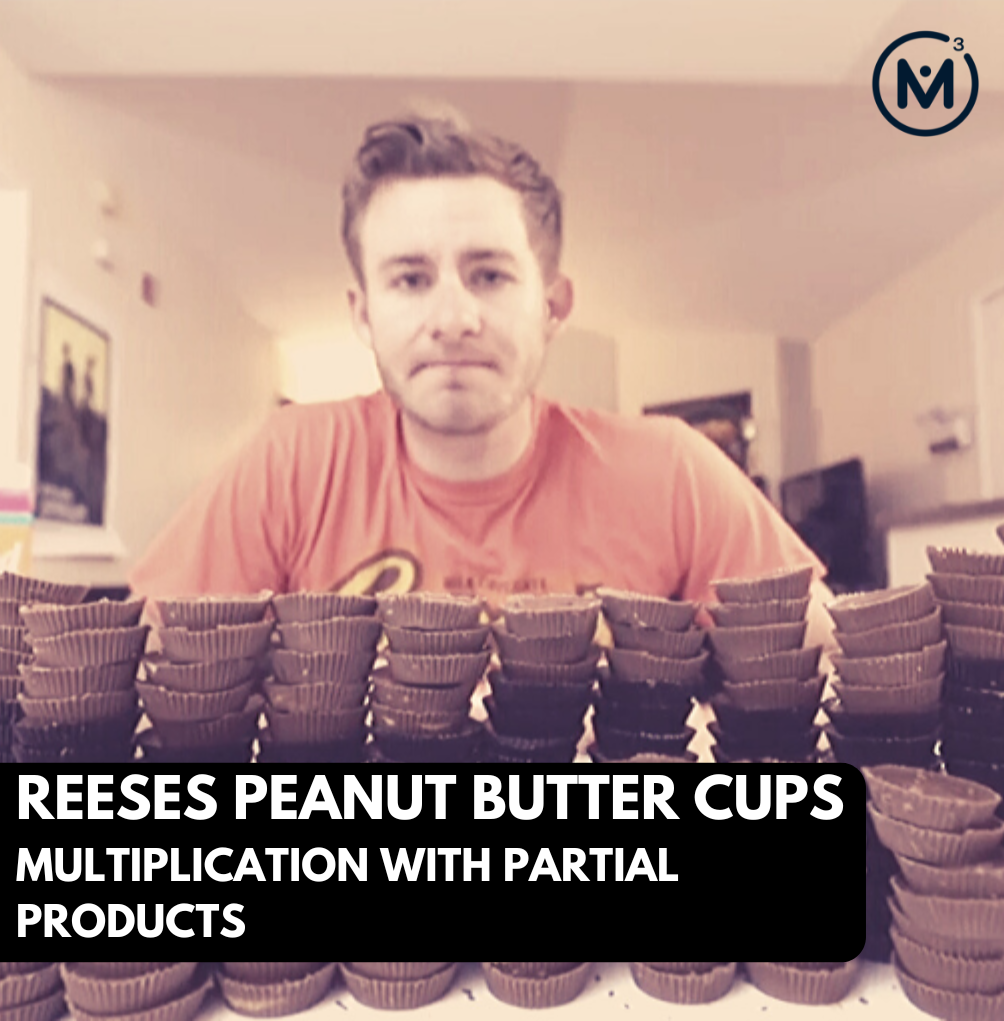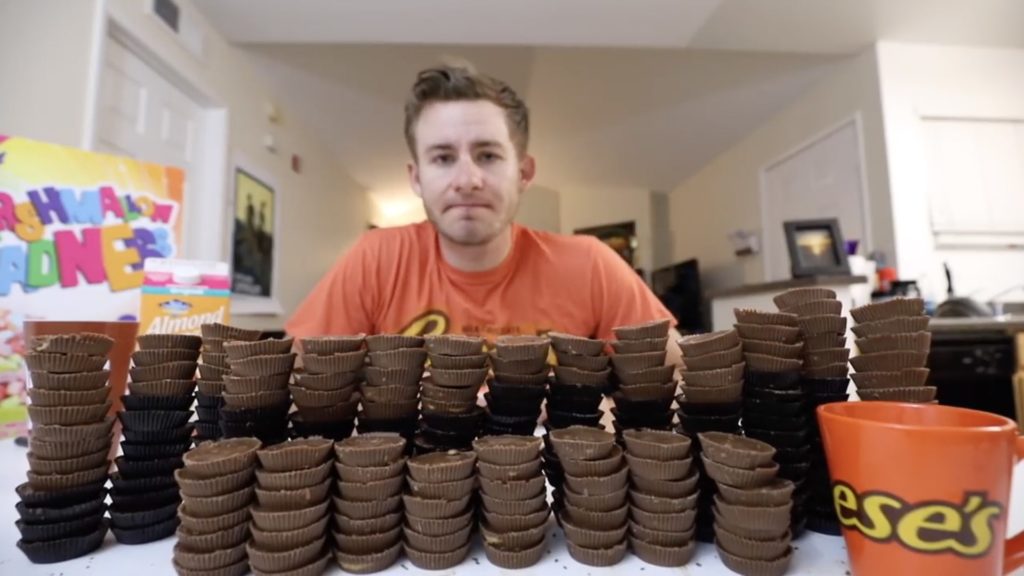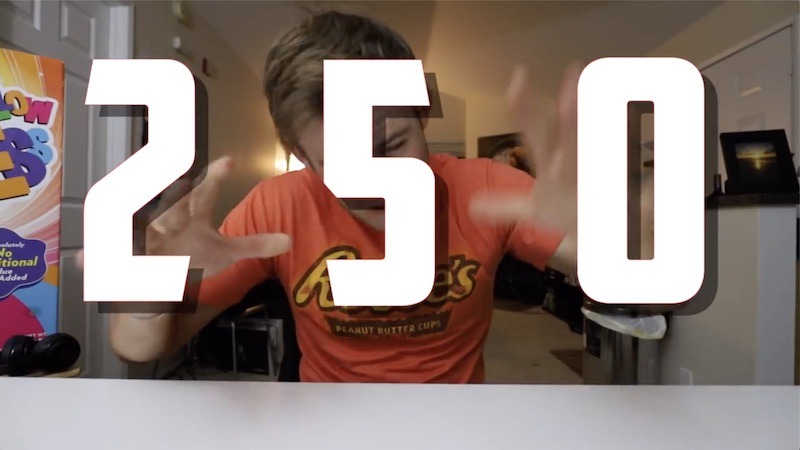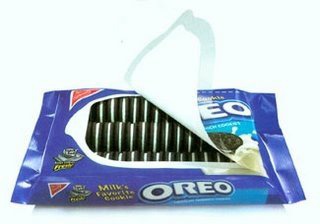REESES PEANUT BUTTER CUPS
Multiplication with partial products
Decompose an array to reveal partial products in order to estimate a large quantity.
Intentionality
Spark Curiosity
Fuel Sensemaking
During Moves
Student Approaches
Next Moves
Consolidation
Reflect and Consolidation Prompts
Resources & Downloads
Educator Discussion Area
Intentionality & Unit Overview

Length of Unit: 5 Days
Access each lesson from this unit using the navigation links below
In this task, students will have an opportunity to reason through an estimation activity. Students are encouraged to consider decomposing the large quantity into smaller arrays in order to make a reasonable estimate. This task will allow students to apply the array model and develop a deeper understanding of big ideas, including the following:
- Numbers can be decomposed
- The relationship between repeated addition and multiplication
- The relationships between rows and columns in an array
- The distributive property of multiplication over addition and over subtraction
Spark Curiosity
What Do You Notice? What Do You Wonder?
Show students the video below displaying ErikTheElectric preparing to eat a large quantity of Reese’s Peanut Butter Cups for his YouTube subscribers.
Ask students to engage in a notice and wonder protocol. ANYTHING and EVERYTHING that comes to mind is fair game.
Write down all of the students’ noticing and wondering. For example:
- Why does he want to eat so much?
- Is he swearing?
- His shirt magically changed.
- How did he do that?
- He went to Target.
- He bought all of the Peanut Butter Cups.
- How much did it cost to buy all of those Peanut Butter Cups?
- How many calories is that?
- And many others…
Take time to acknowledge the noticing and wondering your students have engaged in and try to answer any that you can address right away.
Prompt and Estimate
Then, pose the following question:
How many Reese’s Peanut Butter Cups are there?
Follow up that question with:
How might we convince someone that the quantity you come up with is correct?
Let them loose to make some estimates based on what they saw.
Ask students to estimate a number of Peanut Butter Cups that they think is too high and a number of cups that they think is too low before making their “best estimate”.
Fuel Sense-making
Crafting A Productive Struggle: Prompt
After sharing out their estimates, have students improve the precision of their estimates by using the following video and/or image and they must convince their mathematical community of peers as well as the teacher. After students update their estimates, you may choose to provide the following image giving more detail as to the stacks of peanut butter cups from the above video and image.
After students update their estimates, you may choose to provide the following image giving more detail as to the stacks of peanut butter cups from the above video and image.
 It should be noted that the dimensions shared above are approximations as some rows and columns are not consistent.
It should be noted that the dimensions shared above are approximations as some rows and columns are not consistent. During Moves
While Students Are Productively Struggling…
Monitor student thinking by circulating around the room and listening to the mathematical discourse. Select and sequence some of the student solution strategies and ask a student from the selected groups to share with the class from:
- most accessible to least accessible solution strategies and representations;
- most common/frequent to least common/frequent strategies and representations; or,
- choose another approach to selecting and sequencing student work.
The tools and representations you might see students using to convince their peers and/or the teacher include:
- Connecting cubes, square tiles, or counters to model and count the Peanut Butter Cups.
- Arrays and/or area models drawn to make counting, adding, and/or multiplying the Peanut Butter Cups easier.
- As well as others…
Have students share their strategies and reasoning for determining the number Peanut Butter Cups. Ask them to convince you and their peers that their answer is correct by sharing mathematical models.
Discuss their strategies and elicit student thinking during your consolidation to build off of their current prior knowledge and understanding rather than “fixing” or “funnelling” student thinking to a strategy and/or model that does not connect to their strategy and/or approach.
Student Approaches
Student Approach #1: One-to-One & Doubling
I started with the Peanut Butter Cups in the front and I counted them one at a time. I counted 55.
For the back row. I counted the ones that I could see. I counted 107. I figured that I could see about half of them, so I doubled 107. I did 100 + 100 which gave me 200, and 7 + 7 is 14. 200 + 14 is 214. But I also had to add the Peanut Butter Cups from the front, which was 55. 200 + 55 = 255, 255 + 10 is 265, plus 4 more is 269.
Approach
This student used one-to-one and doubling. The Associative Property of addition helped this student add 214 and 55 by decomposing and re-associating to make friendly numbers.
Student Approach #2: Partial Products
I thought there were about ten Peanut Butter Cups in the second row in each stack.
So I counted by 10 fourteen times. (Student models how they counted by ten and tracked 14 iterations using their fingers).
In the front row, I counted the number of Peanut Butter Cups in one stack that looked to represent the average number in all of the stacks, and that was 7 cups. And I saw that there are 8 stacks, so I counted by 7 eight times. But counting by 7 is hard for me, so I did 5 x 7, which equals 35. And then I did 2 x 7 which is 14. 35 + 14 is 49, and one more 7 is 56.
Then I had to add the front row and the back row together. 140 + 56 gave me 196.
Approach
This student demonstrated an understanding of the relationship between repeated addition and multiplication. This student also used partial products to multiply 8 x 7. This strategy is possible because of the Distributive Property of multiplication over addition.
Student Approach #3: Partial Products and Standard Algorithm
I looked at the front row and back row as two rectangles. The front row looks like a rectangle that is 8 Peanut Butter Cups long by about 7 peanut butter cups wide. I know that 8 x 7 is 56 Peanut Butter Cups.
The back row is a second rectangle that is 14 Peanut Butter Cups long. The other dimension was harder because they are not all the same. But I looked at the first column, and there are 13, and that one looked about average. So I did 14 x 13.
To get that answer, I did (10 x 13) + (4 x 10) + (4 x 3). That’s, 130 + 40 + 12. So that’s 183 Peanut Butter Cups in the back. But then I added the front as well. 182 + 56. To add those together I used the standard algorithm, and I got 238 total.
Approach
This student used their understanding of the relationship between rows and columns in an array to reason through this problem. To multiply 14 x 13, this student used a partial products strategy, the distributive property over addition.
Discuss and consolidate the learning to ensure that the mathematical thinking you intended to elicit is clear to all students. For example, students may recognize the relationship between counting one-to-one, skip counting and multiplication. The big idea of the relationship between rows and columns in an array can be explored.
Next Moves
Reveal
After consolidating learning using student generated solution strategies and by extending their thinking intentionally, we can share what really happened by showing the video below.
Here is a short clip that just reveals the total number of Reese’s Peanut Butter Cups Erik ate:
Answer: 250 Reese’s Peanut Butter Cups
Revisit the student answers. Ask students why their answers may or may not have been exact.
Consolidation
In the consolidation, use student solutions to solidify the array model to visualize multiplication and the strategy of partial products. Some students may still be counting one to one or skip counting. Through the visual of the peanut butter cups, help students see that items organized in rows and columns can be calculated using multiplication. It is also helpful for students to know that they can decompose the array into smaller parts (friendlier facts) and then add them together in order to determine the entire quantity (or product).
Today, you are focusing on a visual array, where you can actually see the peanut butter cups organized into rows and columns. Over time (as students are developmentally ready), you will help them to see that a multiplication sentence such as 15 x 13 can be represented in rows and columns and decomposed into friendler facts in order to find the total product.
Reflect and Consolidation Prompts
Provide students an opportunity to reflect on their learning by offering these consolidation prompts to be completed independently.
Consolidation Prompt #1:
If you used the information given in the image below to calculate the total number of Reese’s Peanut Butter Cups, it is likely that your total didn’t match the total of 250 shared in the video.
Why do you suppose your calculation didn’t match the total from the video? Be specific.
Consolidation Prompt #2:
Oreo cookies have been organized in rows and columns as seen below. There are 3 rows of 14 cookies.
Determine the total number of Oreos. Explain how you might decompose the columns and/or rows to determine the total quantity of Oreos in the most efficient way that you can.
We suggest collecting this reflection as an additional opportunity to engage in the formative assessment process to inform next steps for individual students as well as how the whole class will proceed.
Resources & Downloads
Educator Discussion Area
Login/Join to access the entire Teacher Guide, downloadable slide decks and printable handouts for this lesson and all problem based units.
Explore Our 60+ Problem Based Units
This Make Math Moments Lesson was designed to spark curiosity for a multi-day unit of study with built in purposeful practice, number talks and extensions to elicit and emerge strategies and mathematical models.
Dig into our other units of study and view by concept continuum, grade or topic!





